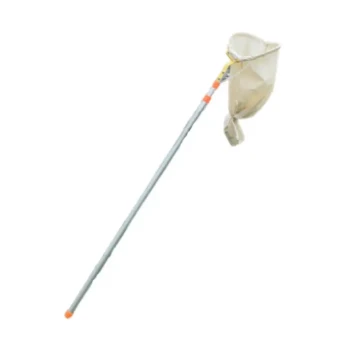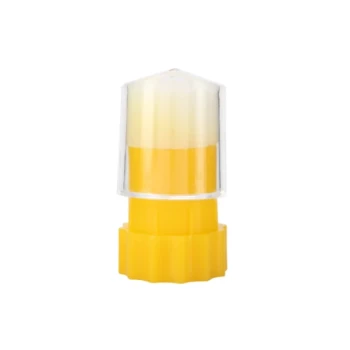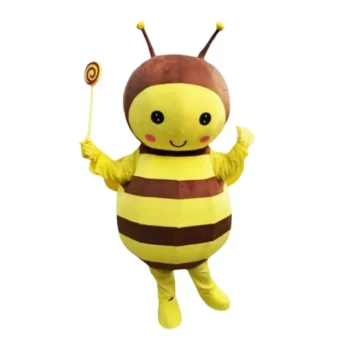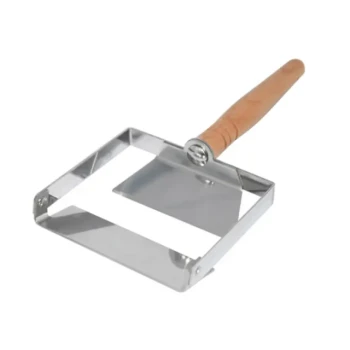In practice, beekeepers catch bees by physically relocating a swarm—a large cluster of bees hanging from a structure like a tree branch—into a hive box. This is most often done by sharply shaking or gently scooping the cluster into the box, ensuring the queen is captured along with them. The goal is not to trap them, but to provide a desirable new home that they will accept willingly.
Capturing bees is a two-part process. First, you physically move the swarm. Second, and more importantly, you convince the bees to stay by providing the resources and conditions that make the new hive a superior home to any other they might find.
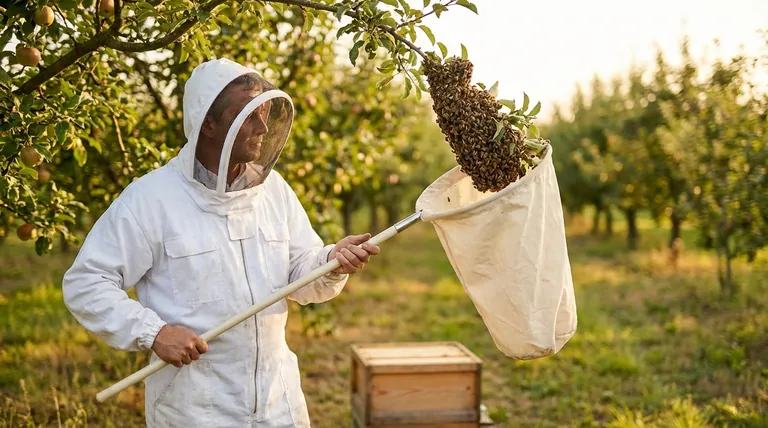
Understanding the "Why" Before the "How"
A swarm is not an angry mob of bees; it's a colony in transit. Understanding their state of mind is the key to capturing them successfully.
Why Bees Swarm
A swarm occurs when a healthy colony outgrows its hive. The old queen leaves with about half the worker bees to find a new home, leaving a new queen to take over the original hive.
The Swarm's Docile Nature
Before swarming, the bees gorge themselves on honey. This makes them full, placid, and less inclined to sting. They have no home, honey, or young to defend, making this the most docile state in which you will ever find honeybees.
Core Techniques for Capturing a Swarm
The physical act of capturing a swarm is surprisingly straightforward. The primary goal is to get the queen into the box; where she goes, the colony will follow.
The "Shake and Drop" Method
This is the most common technique for swarms on accessible branches. The beekeeper places an open hive box directly under the swarm and gives the branch one or two sharp shakes. The entire cluster falls into the box.
The "Cut and Place" Method
If the swarm is on a small, disposable branch, the simplest method is to use pruning shears to cut the entire branch. The beekeeper can then gently place the branch, with bees attached, directly into the new hive.
The "Scoop and Brush" Method
For swarms on a fixed surface like a wall or fence post, shaking isn't an option. Here, a beekeeper will use their gloved hands or a soft bee brush to gently scoop and sweep the bees into the box below. This is repeated until the majority of the bees are in the box.
Securing the Queen
Regardless of the method, the capture is only successful if the queen is in the box. Beekeepers watch the bees' behavior; if bees start marching into the box on their own, it's a strong sign the queen is inside and releasing "come hither" pheromones.
From Capture to Colony: Ensuring They Stay
Getting the bees in the box is only half the battle. You must now convince them this is their new permanent home.
Mimicking a Nectar Flow
A captured swarm has no food reserves beyond what they carried with them. Beekeepers feed them a 1:1 sugar-to-water syrup. This mimics a natural nectar flow, providing the critical energy they need to start building wax comb immediately.
Encouraging Comb Construction
This immediate food source signals to the bees that they have found a resource-rich location. This incentivizes them to stay and invest their energy in building out the hive rather than absconding to look for a better spot.
Understanding the Risks and Realities
While swarm catching is a fundamental beekeeping skill, it is not without its challenges and potential for failure.
The Risk of Absconding
Sometimes, even with a perfect capture and plenty of food, the bees will decide the location is not right and leave within a day or two. This is known as absconding. Factors like hive orientation, ventilation, or nearby disturbances can influence their decision.
Misidentification is Dangerous
Not every buzzing cluster is a honeybee swarm. Yellow jackets, hornets, and wasps can form nests that an untrained eye might misidentify. Attempting to "capture" these insects is ineffective and extremely dangerous.
The Need for Proper Gear
Even a docile swarm can become defensive if handled improperly. A proper bee veil is the absolute minimum piece of protective equipment required, with a full suit and gloves providing comprehensive safety and confidence.
Making the Right Choice for Your Goal
Your approach should be dictated by your role and your experience level.
- If you are a new beekeeper wanting to capture a swarm: Focus on the two-step process: safely transfer the cluster and immediately provide sugar syrup to convince them to stay.
- If you are a homeowner who has found a swarm: Your priority is safety. Do not attempt to remove it yourself; call a local beekeeping association or a professional pest removal service that specializes in live honeybee relocation.
Ultimately, successfully catching bees is less an act of force and more an application of understanding their biology and needs.
Summary Table:
| Step | Key Action | Purpose |
|---|---|---|
| 1 | Identify & Approach Swarm | Ensure cluster is honeybees, not aggressive species. |
| 2 | Choose Capture Method (Shake/Scoop/Cut) | Physically relocate bees into hive box with queen. |
| 3 | Provide Sugar Syrup & Ideal Hive Conditions | Mimic nectar flow to encourage bees to stay and build comb. |
| 4 | Monitor for Absconding Risks | Check for queen acceptance and colony stability. |
Equip your apiary with professional-grade tools from HONESTBEE
Capture and manage swarms confidently with our durable beekeeping supplies. Whether you're a commercial apiary or a distributor, our wholesale-focused operations ensure you get reliable equipment for successful hive establishment.
Contact HONESTBEE today to discuss your bulk supply needs and enhance your beekeeping efficiency!
Visual Guide
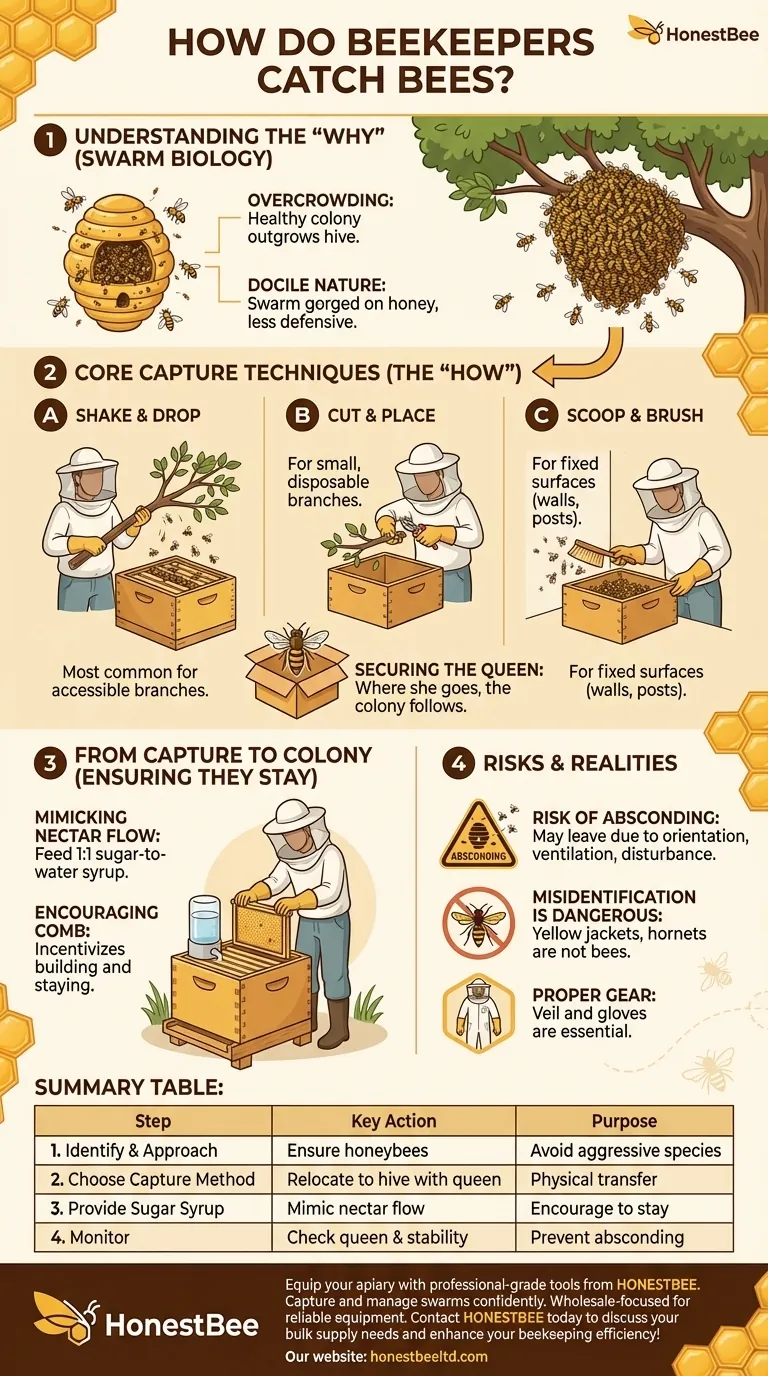
Related Products
- HONESTBEE Professional Telescopic Pole Bee Swarm Catcher
- Professional Multi-Component Bucket Wasp Trap
- Plastic Beetle Blaster Trap Beekeeping Tools and Supplies
- Black Plastic Beetle Barn Hive Beetle Trap for Beehives
- 4 Frame Plastic Nuc Boxes for Beekeeping Bee Nuc Box
People Also Ask
- How do commercial beekeepers prevent swarming? Master Proactive Hive Management
- How should a captured swarm be placed into the hive equipment? A Guide to Secure Hiving
- How can walk-away splits help in swarm prevention? A Proactive Strategy for Beekeepers
- How frequently should pollen be harvested from traps? Optimize Quality and Hive Health
- What are the three main ways to obtain honeybees? Choose the Best Path for Your Apiary
